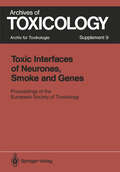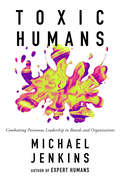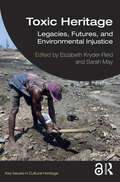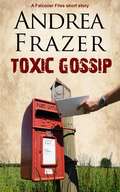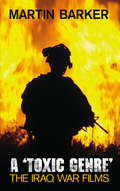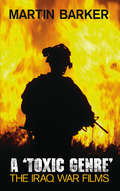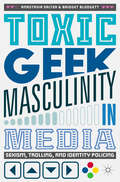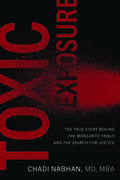- Table View
- List View
Toxic Metals Contamination: Generation, Disposal, Treatment and Valuation
by Jeferson Steffanello Piccin AlMe Dettmer Natarajan ChandrasekaranToxic metals are a class of chemical elements that, in certain concentrations, can cause damage to the health of humans and animals, in addition to impacting ecosystems. These metals are emitted to the environment mainly by anthropological sources, such as industries, extractive processes and burning of fossil fuels. This book presents the main sources of toxic metals emission, demonstrate the state of the art of waste disposal and valuation techniques, especially solids and wastewater treatment.
Toxic Metal Chemistry in Marine Environments
by Muhammad SadiqPresents an integrated chemical behavior of selected toxic metals: arsenic, cadmium, chromium, copper, mercury, and lead. All important processes that may affect their marine chemistry are discussed. Thermodynamic calculations are performed to propose the most probable route of chemical behavior.
Toxic Metal Chemistry in Marine Environments
by Muhammad SadiqPresents an integrated chemical behavior of selected toxic metals: arsenic, cadmium, chromium, copper, mercury, and lead. All important processes that may affect their marine chemistry are discussed. Thermodynamic calculations are performed to propose the most probable route of chemical behavior.
Toxic Masculinity, Casino Capitalism, and America's Favorite Card Game: The Poker Mindset
by Andrew MannoPoker is a centuries-old American game. Why has it become so popular in the twenty-first century? What does current interest in the game tell us about ourselves and some of our most pressing social issues? In this timely and thought-provoking book, Andrew Manno offers important insights into the intersection of gaming, gender, and capitalism that illuminate how the shift to a casino capitalist economy—combined with a culture of toxic masculinity—impacts workers and how it has led to the rise of populism in the United States that manifested in the 2016 election of Donald Trump.
Toxic Masculinity: Men, Meaning, and Digital Media (Masculinity, Sex and Popular Culture)
by Mark McGlashan and John MercerToxic Masculinity brings together scholars across disciplines to explore the ways in which toxic masculinity is constructed, configured and represented online. What is "toxic masculinity"? Examining what it means in the media and public discourse, the contributors have explored a constellation of behaviours, cultures and practices that have been labelled as (or associated with) toxic masculinity including those of politicians, extremists, incels, as well as individual "ordinary" men and their everyday behaviours. Topics covered in the collection include incels and Men Going Their Own Way (MGTOW), bro culture, sexual violence, internalised homophobia, transphobia, white masculinity and political discourse. Toxic Masculinity is intended for a broad spectrum of gender, media, cultural and masculinity studies professionals, academics, researchers and students. The book also includes suggestions for further reading, a discussion of methods used in each chapter and contextual prefaces to make connections between critical questions and cases.
Toxic Masculinity: Men, Meaning, and Digital Media (Masculinity, Sex and Popular Culture)
by John Mercer Mark McGlashanToxic Masculinity brings together scholars across disciplines to explore the ways in which toxic masculinity is constructed, configured and represented online. What is "toxic masculinity"? Examining what it means in the media and public discourse, the contributors have explored a constellation of behaviours, cultures and practices that have been labelled as (or associated with) toxic masculinity including those of politicians, extremists, incels, as well as individual "ordinary" men and their everyday behaviours. Topics covered in the collection include incels and Men Going Their Own Way (MGTOW), bro culture, sexual violence, internalised homophobia, transphobia, white masculinity and political discourse. Toxic Masculinity is intended for a broad spectrum of gender, media, cultural and masculinity studies professionals, academics, researchers and students. The book also includes suggestions for further reading, a discussion of methods used in each chapter and contextual prefaces to make connections between critical questions and cases.
Toxic Leadership: Research and Cases (Routledge Studies in Leadership Research)
by Steven M. Walker Daryl WatkinsToxic Leadership: Research and Cases presents research and cases on toxic leadership that emerged from qualitative research on the followers of toxic leaders. The goal is to help students, researchers, and academics understand how toxic leadership emerges, how leaders can spot toxic leadership within their organizations, and discuss what they can do to stop toxic leaders from destroying organizational value.The book pulls together various theories, models, and names (e.g., bad leadership, destructive leadership) for toxic leadership. The authors cover how power, culture, personality disorders, and followers contribute to the toxic leadership phenomenon. Readers will learn how toxic leaders impact organizations, the types of toxic leaders, signs of toxic leaders, and the environments they create. The authors share case studies for each toxic leader type to illustrate themes, coping strategies, and organizational outcomes. Each case is accompanied by a series of questions for reflection, study, and leadership development.This book will be useful for students, researchers, and academics to help uncover signs of toxic leaders that are often hidden from upper management. It will also be helpful for leaders to develop organizational strategies and for followers to develop coping strategies.
Toxic Leadership: Research and Cases (Routledge Studies in Leadership Research)
by Steven M. Walker Daryl WatkinsToxic Leadership: Research and Cases presents research and cases on toxic leadership that emerged from qualitative research on the followers of toxic leaders. The goal is to help students, researchers, and academics understand how toxic leadership emerges, how leaders can spot toxic leadership within their organizations, and discuss what they can do to stop toxic leaders from destroying organizational value.The book pulls together various theories, models, and names (e.g., bad leadership, destructive leadership) for toxic leadership. The authors cover how power, culture, personality disorders, and followers contribute to the toxic leadership phenomenon. Readers will learn how toxic leaders impact organizations, the types of toxic leaders, signs of toxic leaders, and the environments they create. The authors share case studies for each toxic leader type to illustrate themes, coping strategies, and organizational outcomes. Each case is accompanied by a series of questions for reflection, study, and leadership development.This book will be useful for students, researchers, and academics to help uncover signs of toxic leaders that are often hidden from upper management. It will also be helpful for leaders to develop organizational strategies and for followers to develop coping strategies.
Toxic Interfaces of Neurones, Smoke and Genes: Proceedings of the European Society of Toxicology Meeting Held in Kuopio, June 16–19, 1985 (Archives of Toxicology #9)
by Philip L. Chambers Jouko Tuomisto Claire M. ChambersToxic Interactions and the Social Geography of Psychosis: Reflections on the Epidemiology of Mental Disorder (The International Society for Psychological and Social Approaches to Psychosis Book Series)
by Hugh MiddletonToxic Interactions is a review of quantitative research revealing how urban living, trauma, ethnicity, stress and familial influence the risk of troubling psychotic experiences. Each of these is reviewed in search of their social implications, and a constructivist approach identifies their common threads. The contributions of newer psychotherapeutic approaches such as Open Dialogue and Recovery programmes are considered, and a consistent interpretation emerges; that is not the observable features of disturbed mental state that deserve key attention, but how these are generally understood by others, and in particular the 'client's' close associates. Toxic Interactions and the Social Geography of Psychosis will be welcomed by all who find conventional approaches to mental health difficulties unsatisfactory, whether that is as a practitioner frustrated by the counter-productive expectations of their institutional setting, an academic exploring different perspectives a 'service user' disappointed by not experiencing the care they feel is needed, or as third party perplexed by the contradictions of contemporary psychiatry.
Toxic Interactions and the Social Geography of Psychosis: Reflections on the Epidemiology of Mental Disorder (The International Society for Psychological and Social Approaches to Psychosis Book Series)
by Hugh MiddletonToxic Interactions is a review of quantitative research revealing how urban living, trauma, ethnicity, stress and familial influence the risk of troubling psychotic experiences. Each of these is reviewed in search of their social implications, and a constructivist approach identifies their common threads. The contributions of newer psychotherapeutic approaches such as Open Dialogue and Recovery programmes are considered, and a consistent interpretation emerges; that is not the observable features of disturbed mental state that deserve key attention, but how these are generally understood by others, and in particular the 'client's' close associates. Toxic Interactions and the Social Geography of Psychosis will be welcomed by all who find conventional approaches to mental health difficulties unsatisfactory, whether that is as a practitioner frustrated by the counter-productive expectations of their institutional setting, an academic exploring different perspectives a 'service user' disappointed by not experiencing the care they feel is needed, or as third party perplexed by the contradictions of contemporary psychiatry.
Toxic Inequality: How America's Wealth Gap Destroys Mobility, Deepens the Racial Divide, and Threatens Our Future
by Thomas M. ShapiroFrom a leading authority on race and public policy, a deeply researched account of how families rise and fall todaySince the Great Recession, most Americans' standard of living has stagnated or declined. Economic inequality is at historic highs. But inequality's impact differs by race; African Americans' net wealth is just a tenth that of white Americans, and over recent decades, white families have accumulated wealth at three times the rate of black families. In our increasingly diverse nation, sociologist Thomas M. Shapiro argues, wealth disparities must be understood in tandem with racial inequities--a dangerous combination he terms "toxic inequality." In Toxic Inequality, Shapiro reveals how these forces combine to trap families in place. Following nearly two hundred families of different races and income levels over a period of twelve years, Shapiro's research vividly documents the recession's toll on parents and children, the ways families use assets to manage crises and create opportunities, and the real reasons some families build wealth while others struggle in poverty. The structure of our neighborhoods, workplaces, and tax code-much more than individual choices-push some forward and hold others back. A lack of assets, far more common in families of color, can often ruin parents' careful plans for themselves and their children.Toxic inequality may seem inexorable, but it is not inevitable. America's growing wealth gap and its yawning racial divide have been forged by history and preserved by policy, and only bold, race-conscious reforms can move us toward a more just society."Everyone concerned about the toxic effects of inequality must read this book."--Robert B. Reich"This is one of the most thought-provoking books I have read on economic inequality in the US."--William Julius Wilson
Toxic Inequality: How America's Wealth Gap Destroys Mobility, Deepens the Racial Divide, and Threatens Our Future
by Thomas M. ShapiroFrom a leading authority on race and public policy, a deeply researched account of how families rise and fall today Since the Great Recession, most Americans' standard of living has stagnated or declined. Economic inequality is at historic highs. But inequality's impact differs by race; African Americans' net wealth is just a tenth that of white Americans, and over recent decades, white families have accumulated wealth at three times the rate of black families. In our increasingly diverse nation, sociologist Thomas M. Shapiro argues, wealth disparities must be understood in tandem with racial inequities -- a dangerous combination he terms "toxic inequality." In Toxic Inequality, Shapiro reveals how these forces combine to trap families in place. Following nearly two hundred families of different races and income levels over a period of twelve years, Shapiro's research vividly documents the recession's toll on parents and children, the ways families use assets to manage crises and create opportunities, and the real reasons some families build wealth while others struggle in poverty. The structure of our neighborhoods, workplaces, and tax code-much more than individual choices-push some forward and hold others back. A lack of assets, far more common in families of color, can often ruin parents' careful plans for themselves and their children. Toxic inequality may seem inexorable, but it is not inevitable. America's growing wealth gap and its yawning racial divide have been forged by history and preserved by policy, and only bold, race-conscious reforms can move us toward a more just society."Everyone concerned about the toxic effects of inequality must read this book." -- Robert B. Reich "This is one of the most thought-provoking books I have read on economic inequality in the US." -- William Julius Wilson
Toxic Humans: Combatting Poisonous Leadership in Boards and Organisations
by Michael JenkinsInternational leadership expert Michael Jenkins shines a light on the adverse effects of dysfunctional and toxic boards and how they have the potential to destroy an organisation’s culture. This can happen through erosion of brand value leading to talent attrition and increased mental health issues in employees due to a deterioration in trust and psychological safety. Combined with recent fundamental changes in the labour market and demographic changes in the workforce, there is a potent cocktail of Future of Work issues that will not go away. Enlightened leaders must tackle such issues head-on if they are to steward sustainable and responsible organisations and businesses. Based on extensive research, including interviews with board members from around the world, together with one-to-one interviews with leaders from the VAB (Virtual Advisory Board) network, Toxic Humans: Combatting Poisonous Leadership in Boards and Organisations outlines various experiences of toxic leadership and how successful directors managed to work with and through it. These interviews shape the final sections of the book where the reader is given a set of recommendations for action to help mitigate and manage the effect of toxic leadership – at the Board, senior leader and team levels - and to build a positive and productive workplace where all can flourish.
Toxic Humans: Combatting Poisonous Leadership in Boards and Organisations
by Michael JenkinsInternational leadership expert Michael Jenkins shines a light on the adverse effects of dysfunctional and toxic boards and how they have the potential to destroy an organisation’s culture. This can happen through erosion of brand value leading to talent attrition and increased mental health issues in employees due to a deterioration in trust and psychological safety. Combined with recent fundamental changes in the labour market and demographic changes in the workforce, there is a potent cocktail of Future of Work issues that will not go away. Enlightened leaders must tackle such issues head-on if they are to steward sustainable and responsible organisations and businesses. Based on extensive research, including interviews with board members from around the world, together with one-to-one interviews with leaders from the VAB (Virtual Advisory Board) network, Toxic Humans: Combatting Poisonous Leadership in Boards and Organisations outlines various experiences of toxic leadership and how successful directors managed to work with and through it. These interviews shape the final sections of the book where the reader is given a set of recommendations for action to help mitigate and manage the effect of toxic leadership – at the Board, senior leader and team levels - and to build a positive and productive workplace where all can flourish.
Toxic Heritage: Legacies, Futures, and Environmental Injustice (Key Issues in Cultural Heritage)
by Elizabeth Kryder-Reid Sarah MayToxic Heritage addresses the heritage value of contamination and toxic sites and provides the first in-depth examination of toxic heritage as a global issue. Bringing together case studies, visual essays, and substantive chapters written by leading scholars from around the world, the volume provides a critical framing of the globally expanding field of toxic heritage. Authors from a variety of disciplinary perspectives and methodologies examine toxic heritage as both a material phenomenon and a concept. Organized into five thematic sections, the book explores the meaning and significance of toxic heritage, politics, narratives, affected communities, and activist approaches and interventions. It identifies critical issues and highlights areas of emerging research on the intersections of environmental harm with formal and informal memory practices, while also highlighting the resilience, advocacy, and creativity of communities, scholars, and heritage professionals in responding to the current environmental crises. Toxic Heritage is useful and relevant to scholars and students working across a range of disciplines, including heritage studies, environmental science, archaeology, anthropology, and geography.
Toxic Heritage: Legacies, Futures, and Environmental Injustice (Key Issues in Cultural Heritage)
Toxic Heritage addresses the heritage value of contamination and toxic sites and provides the first in-depth examination of toxic heritage as a global issue. Bringing together case studies, visual essays, and substantive chapters written by leading scholars from around the world, the volume provides a critical framing of the globally expanding field of toxic heritage. Authors from a variety of disciplinary perspectives and methodologies examine toxic heritage as both a material phenomenon and a concept. Organized into five thematic sections, the book explores the meaning and significance of toxic heritage, politics, narratives, affected communities, and activist approaches and interventions. It identifies critical issues and highlights areas of emerging research on the intersections of environmental harm with formal and informal memory practices, while also highlighting the resilience, advocacy, and creativity of communities, scholars, and heritage professionals in responding to the current environmental crises. Toxic Heritage is useful and relevant to scholars and students working across a range of disciplines, including heritage studies, environmental science, archaeology, anthropology, and geography.
Toxic Hazards in Food (Croom Helm Biology in Medicine Series)
by David M. Conning A. B. LansdownIn the world of plentiful, cheap food that so many of us in the Western World have come to accept as our birthright, it takes sensational journalism and horrific television coverage to make us realise that not all of the world's population shares this abundance. Visits to the Soviet Bloc countries, to China, most African states and various other coun tries of the Third World make one quickly realise that widespread shortage of food is just over the horizon and would be common experi ence to all were it not for the advanced technologies of Western agricul ture, food production and food manufacture. Without doubt, pesticides and other agricultural chemicals have made enormous contributions to world food production - and indeed to world peace. The introduction of many food additives, especially antioxidants, has also contributed greatly to the amount and quality of food which is available, preventing early spoilage and waste, and possibly indirectly contributing to man's health, as these antioxidants have been shown to have beneficial proper ties in the prevention of experimental malignancy and cardiovascular disease. Nevertheless, despite the enormous benefits derived from the use of agrochemicals and food additives, it is essential to remember that these are all selectively toxic chemicals, with no absolute guarantee of safety, and where the benefit to risk ratio is always a compromise adjusted by the expediency of political and financial aspects of food production.
Toxic Gossip: Brief Case (Briefcases #4)
by Andrea FrazerA Falconer short story in a more sombre mood.DI Falconer becomes involved in a gossip-fuelled hate crime, only to find himself questioning his own judgement when it comes to protecting Miriam Darling from her anonymous persecutors …
A 'Toxic Genre': The Iraq War Films
by Martin BarkerOver the last five years, a cycle of films has emerged addressing the ongoing Iraq conflict. Some became well-known and one of them, The Hurt Locker, won a string of Oscars. But many others disappeared into obscurity. What is it about these films that led Variety to dub them a 'toxic genre'?*BR**BR*Martin Barker analyses the production and reception of these recent Iraq war films. Among the issues he examines are the borrowing of soldiers' YouTube styles of self-representation to generate an 'authentic' Iraq experience, and how they take refuge in 'apolitical' post-traumatic stress disorder. Barker also looks afresh at some classic issues in film theory: the problems of accounting for film 'failures', the shaping role of production systems, the significance of genre-naming and the impact of that 'toxic' label.*BR**BR*A 'Toxic Genre' is fascinating reading for film studies students and anyone interested in cinema's portrayal of modern warfare.
A 'Toxic Genre': The Iraq War Films
by Martin BarkerOver the last five years, a cycle of films has emerged addressing the ongoing Iraq conflict. Some became well-known and one of them, The Hurt Locker, won a string of Oscars. But many others disappeared into obscurity. What is it about these films that led Variety to dub them a 'toxic genre'?*BR**BR*Martin Barker analyses the production and reception of these recent Iraq war films. Among the issues he examines are the borrowing of soldiers' YouTube styles of self-representation to generate an 'authentic' Iraq experience, and how they take refuge in 'apolitical' post-traumatic stress disorder. Barker also looks afresh at some classic issues in film theory: the problems of accounting for film 'failures', the shaping role of production systems, the significance of genre-naming and the impact of that 'toxic' label.*BR**BR*A 'Toxic Genre' is fascinating reading for film studies students and anyone interested in cinema's portrayal of modern warfare.
Toxic Geek Masculinity in Media: Sexism, Trolling, and Identity Policing
by Anastasia Salter Bridget BlodgettThis book examines changing representations of masculinity in geek media, during a time of transition in which “geek” has not only gone mainstream but also become a more contested space than ever, with continual clashes such as Gamergate, the Rabid and Sad Puppies’ attacks on the Hugo Awards, and battles at conventions over “fake geek girls.” Anastasia Salter and Bridget Blodgett critique both gendered depictions of geeks, including shows like Chuck and The Big Bang Theory, and aspirational geek heroes, ranging from the Winchester brothers of Supernatural to BBC’s Sherlock and the varied superheroes of the Marvel Cinematic Universe. Through this analysis, the authors argue that toxic masculinity is deeply embedded in geek culture, and that the identity of geek as victimized other must be redefined before geek culture and media can ever become an inclusive space.
Toxic Game (Ghostwalker Novel #15)
by Christine FeehanOn a rescue mission in the heart of the Indonesian jungle, Dr. Draden Freeman and his GhostWalker team need to extract the wounded as quickly as possible - or risk spreading a deadly virus unleashed by a terrorist cell. When Draden himself gets infected, he forces his team to leave him behind. He won't risk exposing anyone else. He intends to find the ones responsible and go out in a blaze of glory . . .Shylah Cosmos's mission is to track the virus and remain unseen. Her enhanced senses tell her that the gorgeous man eradicating the terrorists one by one is a GhostWalker - and his lethal precision takes her breath away. When he's hit by a lucky shot, she can't stop herself from stepping in, not knowing that by saving his life she's exposed herself to the virus.There's no telling how much time Draden and Shylah have left. Racing to find a cure, they quickly realize that they've found their perfect partner just in time to lose everything. But even as the virus threatens to consume their bodies, they've never felt more alive.Praise for Christine Feehan and the New York Times bestselling GhostWalker novels'The queen of paranormal romance! I love everything she does' J.R. Ward, No. 1 New York Times bestselling author'Romance, suspense, danger, action-packed excitement, hot hot men, and on top of all that, a couple that sizzles all throughout the book... Sexy as hell' The Reading Cafe'I cannot wait to see where Ms. Feehan takes us next' Fresh Fiction
Toxic Exposure: The True Story behind the Monsanto Trials and the Search for Justice
by Chadi NabhanA behind-the-scenes look inside three key trials involving Monsanto's weed killer Roundup, cancer, and the search for justice—written by an expert witness medical oncologist who lived it all.For years, Monsanto declared that their product Roundup, the world's most widely used weed killer, was safe. But that all changed in 2015, when the International Agency for Research on Cancer (IARC) analyzed data from scientific studies and concluded that glyphosate, the active ingredient in Roundup, is probably carcinogenic. The Environmental Protection Agency (EPA) disagreed, other regulatory agencies got involved, and scientists clamored to understand the link between glyphosate and cancer.Toxic Exposure tells the true story of numerous patients who developed non-Hodgkin lymphoma, a form of cancer, after using Roundup and their ensuing trials against Monsanto (now owned by Bayer, one of the largest agrochemical companies in the world). Written by Chadi Nabhan, MD, MBA, a cancer specialist, this is the only book written by an expert physician witness who testified in the first three trials against Monsanto.Dr. Nabhan takes the reader behind the scenes of these pivotal trials, explaining key features of the cases, including how Monsanto downplayed the IARC's scientific conclusions, may have worked to change how the EPA classified glyphosate, and conducted extensive PR campaigns designed to minimize the public's perception of the negative health effects of its product. He also provides details about the other expert witnesses who reviewed the evidence, analyzed the science, and stood up to this agricultural behemoth in the courtroom. Dr. Nabhan tells the inside story of corporate influence, courtroom drama, legal discourse, monumental verdicts, and the ensuing media frenzy surrounding this massive uncovering of the truth and the years of scientific and legal work that led up to it.
Toxic Exposure: The True Story behind the Monsanto Trials and the Search for Justice
by Chadi NabhanA behind-the-scenes look inside three key trials involving Monsanto's weed killer Roundup, cancer, and the search for justice—written by an expert witness medical oncologist who lived it all.For years, Monsanto declared that their product Roundup, the world's most widely used weed killer, was safe. But that all changed in 2015, when the International Agency for Research on Cancer (IARC) analyzed data from scientific studies and concluded that glyphosate, the active ingredient in Roundup, is probably carcinogenic. The Environmental Protection Agency (EPA) disagreed, other regulatory agencies got involved, and scientists clamored to understand the link between glyphosate and cancer.Toxic Exposure tells the true story of numerous patients who developed non-Hodgkin lymphoma, a form of cancer, after using Roundup and their ensuing trials against Monsanto (now owned by Bayer, one of the largest agrochemical companies in the world). Written by Chadi Nabhan, MD, MBA, a cancer specialist, this is the only book written by an expert physician witness who testified in the first three trials against Monsanto.Dr. Nabhan takes the reader behind the scenes of these pivotal trials, explaining key features of the cases, including how Monsanto downplayed the IARC's scientific conclusions, may have worked to change how the EPA classified glyphosate, and conducted extensive PR campaigns designed to minimize the public's perception of the negative health effects of its product. He also provides details about the other expert witnesses who reviewed the evidence, analyzed the science, and stood up to this agricultural behemoth in the courtroom. Dr. Nabhan tells the inside story of corporate influence, courtroom drama, legal discourse, monumental verdicts, and the ensuing media frenzy surrounding this massive uncovering of the truth and the years of scientific and legal work that led up to it.





